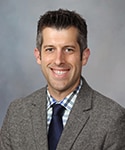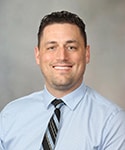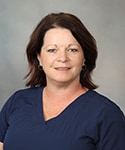Curriculum
/prod01/channel_2/media/mccms/content-assets/academics/health-sciences-training/nuclear-medicine-technology-program-minnesota/nuc-med-tech-mn-MRI-1024X512-WF176152_032.jpg)
of program time, approximately, is spent in the classroom
of program time, approximately, is spent in a clinical setting with patients (clinical orientation, phlebotomy, clinical rotations)
Classroom learning and clinical observations
The Nuclear Medicine Technology Program schedules classroom instruction primarily in the fall, followed by hands-on clinical rotations. However, part-time clinical observations begin the first week of the program.
A building block approach is used for all instruction. Lectures and workshops start with a review of college coursework and build on those concepts as they apply to nuclear medicine. Academic coursework is coordinated with clinical experiences to optimize student learning.
You gain supervised clinical experience using state-of-the-art equipment, including specialized computers, gamma cameras with advanced single-photon emission computerized tomography (SPECT) and SPECT-CT capabilities, solid-state detector gamma cameras, and positron emission tomography and computerized tomography (PET-CT).
Clinical rotations
Clinical rotations in each area of imaging and nuclear pharmacy are one to two weeks in length. As your knowledge and skills in nuclear medicine increase, supervision is reduced, allowing you to function more independently on routine procedures.
The volume and variety of exams performed at Mayo Clinic results in exposure to a wide range of clinical experiences. The clinical experiences offered through this program successfully prepare students to competently practice in their profession.
Elective rotations
Students who are in good standing academically and clinically may be offered a four-week elective rotation to Mayo Clinic's campuses in Arizona or Florida.
This rotation provides an intensive clinical experience across a broader range of practice environments. These rotations take place between March and June. Mayo Clinic funds the authorized additional costs for those selected.
You may elect to participate in a two-week rotation at one of our other regional clinical affiliate sites during the spring and summer, including:
- Mayo Clinic Health System — Franciscan Healthcare in La Crosse, Wisconsin
- Mayo Clinic Health System in Mankato, Minnesota
- Mayo Clinic Health System in Eau Claire, Wisconsin
- CentraCare Heart and Vascular Center at St. Cloud Hospital in St. Cloud, Minnesota
Course sequence
The curriculum for the Nuclear Medicine Technology Program is taught on a semester-based schedule to match the academic structure of our program affiliates.
There are 34 total credits in this program.
Fall semester I
| Course | Credits |
|---|---|
| NUMT 4002 -Anatomy, Physiology, and Pathology | 2 |
| NUMT 4007 -Clinical Nuclear Practicum I | 6 |
| NUMT 4010 - Nuclear Radiation Physics and Instrumentation | 5 |
| NUMT 4013 - Radiopharmacy and Pharmacology | 4 |
Spring semester II
| Course | Credits |
|---|---|
| NUMT 4001 - Management and Methods of Patient Care | 1 |
| NUMT 4003 - Radiation Protection | 4 |
| NUMT 4008 - Clinical Nuclear Practicum II | 8 |
| NUMT 4015 - Multi-Modality Imaging | 4 |
Curriculum enhancements
Mayo Clinic School of Health Sciences is committed to developing and maintaining the best education programs. The curriculum and other aspects of this program are routinely assessed and changed as necessary to ensure the highest quality training.
A day in the life photo gallery
Get a feel for some of the common experiences you'll have throughout the curriculum.
Facilities and equipment
The nuclear medicine facility at Mayo Clinic is the largest in the region, performing more than 30,000 procedures annually. These procedures are performed throughout Mayo Clinic's campus in Rochester, Minnesota.
As a nuclear medicine student, you will gain clinical experience using state-of-the-art equipment including:
- D-SPECT scanners (cardiac)
- SPECT only scanners
- SPECT/CT scanners
- PET/CT scanners (clinical and research)
- PET/MR scanner
- Molecular Breast Imaging (MBI) systems
In addition, you will observe in our cyclotron area, which consists of two cyclotrons.
You will also gain hands-on experience in a radiopharmacy (nuclear pharmacy).
Schedule and hours
For the majority of the program, your learning schedule includes eight-hour days, five days a week. While the regular week is usually 40 hours, additional projects and homework are assigned.
No credit is given for previous work experience.
Department and faculty
Dedicated program faculty members provide an educational experience that is centered on student success. The Nuclear Medicine Technology Program draws its faculty from the clinical, scientific, and technical staffs of Mayo Clinic. Faculty members are chosen for their commitment to teaching, as well as clinical practice and research. Many have published and lectured extensively and are highly regarded in their fields.
Mayo Clinic's campus in Rochester, Minnesota, is home to approximately 100 nuclear medicine technologists alone. Joining our multidisciplinary team are physicians, nurses, physicists, radiopharmacists, radiochemists, and several support and administrative staff members.
Students have access to these individuals throughout the program, giving them the opportunity to learn directly from some of today's best nuclear medicine practitioners. The unique combination of time with program faculty members in the classroom and clinical settings delivers individualized mentoring to support student success.
Meet the core faculty
Stephen Broski, M.D.
Stephen Broski, M.D.
Medical Director
Assistant Professor of Radiology
 Dr. Broski is from Rockford, Illinois, and graduated from Augustana College with a B.S. in biology in 2005. He obtained his medical degree from the University of Michigan in 2009 and completed an internship at Aurora St. Luke’s Hospital in Milwaukee, Wisconsin. He then completed a residency in diagnostic radiology and fellowships in musculoskeletal and nuclear radiology at Mayo Clinic, Rochester before joining staff in 2015. Shortly after beginning on staff, he assumed the role of Medical Director of the Nuclear Medicine Technology Program. He is currently holding the rank of Assistant Professor in the Department of Radiology.
Dr. Broski is from Rockford, Illinois, and graduated from Augustana College with a B.S. in biology in 2005. He obtained his medical degree from the University of Michigan in 2009 and completed an internship at Aurora St. Luke’s Hospital in Milwaukee, Wisconsin. He then completed a residency in diagnostic radiology and fellowships in musculoskeletal and nuclear radiology at Mayo Clinic, Rochester before joining staff in 2015. Shortly after beginning on staff, he assumed the role of Medical Director of the Nuclear Medicine Technology Program. He is currently holding the rank of Assistant Professor in the Department of Radiology.
Dr. Broski’s research interests include PET/CT, PET/MRI, and MRI evaluation of bone tumors, soft tissue tumors, and peripheral neuropathic conditions. He is currently a member of the Radiologic Society of North America, American Roentgen Ray Society, Society of Skeletal Radiology, Society of Nuclear Medicine and Molecular Imaging, and International Society for Magnetic Resonance in Medicine.
Matthew Ugorowski, M.Ed., C.N.M.T.
Matthew Ugorowski, M.Ed., C.N.M.T.
Program Director
 Matthew Ugorowski is originally from Southeast Michigan. Mr. Ugorowski graduated from Oakland University in Rochester, Michigan, in December 2011. While at Oakland University, he earned a B.S. in biomedical diagnostic and therapeutic science with a specialization in nuclear medicine technology. Mr. Ugorowski later graduated from the College of St. Scholastica in Duluth, Minnesota, with a Master of Education (M.Ed.) in May 2016. In conjunction with his M.Ed., Matthew earned a certificate in educational technology.
Matthew Ugorowski is originally from Southeast Michigan. Mr. Ugorowski graduated from Oakland University in Rochester, Michigan, in December 2011. While at Oakland University, he earned a B.S. in biomedical diagnostic and therapeutic science with a specialization in nuclear medicine technology. Mr. Ugorowski later graduated from the College of St. Scholastica in Duluth, Minnesota, with a Master of Education (M.Ed.) in May 2016. In conjunction with his M.Ed., Matthew earned a certificate in educational technology.
Beginning in October 2012, Mr. Ugorowski worked as full-time nuclear medicine technologist at Mayo Clinic, Rochester. Shortly after, he served as a didactic and clinical instructor for the Mayo Clinic School of Health Sciences (MCSHS) Nuclear Medicine Technology (NMT) Program. In March 2015, He transitioned to Clinical Coordinator for the MCSHS NMT Program for approximately two years. After gaining additional experience as a radiology manager, he joined the MCSHS NMT Program as Program Director in May 2018.
Mr. Ugorowski’s teaching interests include the integration of simulation-based methodologies in health science education. He has also coached five NMT Program student quiz bowl teams between two states. Four of five teams have earned the Central Chapter – Society of Nuclear Medicine and Molecular Imaging Quiz Bowl Championship. He is a member of the Society of Nuclear Medicine and Molecular Imaging.
Michelle Bartel, NMTCB
Michelle Bartel, NMTCB
Clinical Coordinator, Staff Technologist
 Michelle Bartel graduated from the University of Wisconsin, La Crosse, where she earned a B.S. in nuclear medicine technology and a minor in chemistry in 1991. Ms. Bartel attended the Mayo Clinic School of Health Related Sciences in the Nuclear Medicine Technology (NMT) Program where she earned a certificate in August of 1991.
Michelle Bartel graduated from the University of Wisconsin, La Crosse, where she earned a B.S. in nuclear medicine technology and a minor in chemistry in 1991. Ms. Bartel attended the Mayo Clinic School of Health Related Sciences in the Nuclear Medicine Technology (NMT) Program where she earned a certificate in August of 1991.
Ms. Bartel joined the Nuclear Medicine Department at Mayo Clinic as a staff technologist in 1991. In May 2015, she joined the NMT Program as a clinical coordinator. Her teaching interests include endocrinology, oncology, and gastroenterology, as well as clinical practice.
Grading and evaluation
This program primarily uses these evaluative tools:
- Self-assessment exercises
- Electronic formative and summative assessments
- Individual and team-based assignments/projects
- Demonstration of skills
- Faculty reviews
Our system of evaluation provides students and faculty with a comprehensive look at individual performance. This allows faculty and administrative staff to direct students who are experiencing academic difficulty to the appropriate support resources, including touring programs, and counseling opportunities.
Clinical requirements
In order to meet the clinical requirements for graduation, students must:
- Demonstrate satisfactory performance of clinical objectives for all clinical practicum rotations
- Complete all clinical competencies identified in the clinical manual
Didactic requirements
In order to meet the didactic requirements for graduation, students must complete all:
- Courses listed in the program curriculum with a grade of C or better
- Graduation requirements of the baccalaureate-granting university or have completed a baccalaureate degree prior to beginning the program
Graduation and certification
After successfully completing this program, you receive a certificate of completion from Mayo Clinic School of Health Sciences and, if applicable, a baccalaureate degree from your college or university.
Graduates are eligible to take the professional certification examinations given by the Nuclear Medicine Technology Certification Board (NMTCB) and the American Registry of Radiologic Technologists (ARRT).